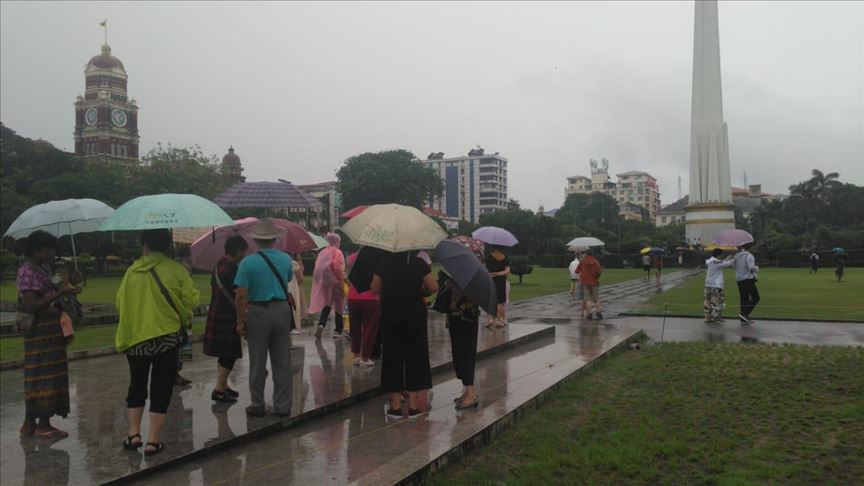‘Zero-dollar tourism’ surges in Myanmar
YANGON, Myanmar
Tourist arrivals in Myanmar are on the rise despite international condemnation over its military’s systematic campaign of violence against the country’s Rohingya Muslim minority.
The growing debate over a tourism boycott is vexing tourists, and the Rohingya exodus obviously contributed to a downturn in the arrival of tourists from European and western countries.
In 2017, the year Myanmar’s military crackdown on Rohingya Muslims in Rakhine state forced around 750,000 people to take shelter in Bangladesh, the country hosted 3.44 million tourists, which rose to 3.55 million in 2018.

But the Myanmar tourism sector faced a challenging situation with a sharp decline (15-20%) on arrival of western tourists.
“But 2019 is making a turnaround,” said Hlaing Oo, deputy permanent secretary of Hotels and Tourism Ministry.
The ministry estimated tourist arrivals this year would exceed the expectation of 6 million after the rainy season from June-September, he told Anadolu Agency by phone on Monday.
According to government data, the country has registered a total of 2.14 million tourists in the first six months of this year, a 24% increase compared to the same period last year (1.72 million).
Chinese tourists flock to Mandalay
Hlaing Oo said the arrival of tourists from some European countries such as Germany, Italy, Spain, and Austria showed a slight increase, but acknowledged that tourist arrivals from Asian countries made up to a 90% increase in 2019.
“Chinese top the list of Asian visitors,” he said.
He said the arrival of Chinese tourists to the country had nearly doubled since visa rules were relaxed in September 2018.

“Mandalay is their favorite place to visit,” he said, referring to Myanmar’s second-largest city in the upper part of the country.
Mandalay was the royal capital of Myanmar’s last dynasty and offers a peak into the region’s rich cultural past. Its ancient Bagan city is recognized as a World Heritage Site by UNESCO.
Due to the inflow of Chinese tourists this year, China’s airlines have been increasing the number of direct flights to the city.
According to government data, nearly 90,000 out of 218,901 tourists who visited Mandalay in the first six months of this year are Chinese.
“It is a tenfold rise compared to the number of Chinese tourists over the same period last year,” said the director at Hotels and Tourism Ministry, San Yu, who is based in Mandalay.
Nay Chi, a 25-years-old resident of Yangon, recently visited Bagan and saw major destinations were crowded with Chinese tourists.
“I was a bit surprised to see such a crowd during the low season,” she told Anadolu Agency on Monday, referring to the rainy season during which fewer people visit the country.
Tour packages bring headache
Surprisingly, this surge of Chinese tourists is not benefiting the local community.
Chinese tour operators control the entire travel process from bookings, flights, hotels and tour arrangements. They offer tourists low-cost tour packages — mostly known as zero-dollar or zero-budget tours.
Thant Zaw, vice-chair of Myanmar Tourism Entrepreneurs Association for Mandalay region, said the package involves tightly scheduled itineraries of hotels, transportation, restaurants and retail shops connected to these Chinese tour operators.
“So it has little or no benefit for the local community,” he told Anadolu Agency by phone on Tuesday.
Under the package tours, visitors have to buy jewelry and souvenirs at higher prices from shops that are linked with the tour company, according to Zaw.
He said Chinese visitors do not use the Myanmar currency (Kyat), instead, they used the Chinese currency (Yuan) and digital payment platform such as WeChat Pay.
“The government is also not getting the right amount of revenue from this kind of tourism,” he said.
The tour packages, moreover, do not hire local tour guides who are registered and licensed at the Ministry of Hotels and Tourism, instead, they hire Chinese tour guides who speak Myanmar language with little knowledge on the country’s tourism and history, said Thant Zaw.
Hard choice for Myanmar
Despite a growing call from locals, authorities seem reluctant to crackdown or regulate the zero-dollar tourism run by Chinese tour operators.
A senior official at Hotels and Tourism Ministry described the issue as a “complicated and delicate problem.”
In the wake of the Rohingya crisis that contributes to the decline in tourist arrival from Europe and America, Myanmar in 2018 adopted a “Look East” policy to attract visitors from Asia. And it apparently works.
“We saw more than 100% increase in Chinese tourist arrival in a year (since visa exemption in late 2018),” said the official, who asked not to be named as he was not authorized to speak to the media.
“We also worry if we would see a decline in tourist arrival if we take action against zero-dollar tour operators,” he said.
He admitted that such kind of tourism business must be properly regulated so that the sector growth is sustained.
“We are learning from the neighboring countries’ experience,” he said, adding that they currently have no plan to take action against the zero-dollar tour operators.
Zero-dollar tourism operated by Chinese tour companies has been thriving in some Asian countries. Thailand, one of the popular destinations for Chinese visitors, cracked down on zero-dollar tourism in recent years, highlighting the mistreatment such as forcing tourists to buy lesser quality souvenirs at higher prices.
Source: https://www.aa.com.tr/en/asia-pacific/zero-dollar-tourism-surges-in-myanmar/1541239


 Thailand
Thailand




